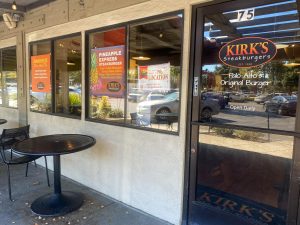Campus feels inflation’s impacts
March 8, 2022

Gas prices are up, Girl Scout cookies cost an extra dollar and “student meals” at Town & Country are increasingly sticker-shocking — inflation is on the rise nationally, and Palo Alto High School students and staff are feeling it.
Since January 2021, inflation rates have risen from 1.4% to the current 7.5% — well above the Federal Reserve policymakers’ healthy yearly rate of approximately 2% or below.
Paly economics teacher Grant Blackburn said the COVID-19 pandemic likely contributed to price jumps due to sudden supply and demand shifts.
“A lot of people up until recently haven’t gone out and done much, so there’s a lot of pent-up demand,” Blackburn said. “So after having saved up all that money, and also just getting kind of tired of sitting around the house, people are anxious to go out and spend the money.”
According to Blackburn, another big factor contributing to inflation has been the stimulus packages, which included two bills in 2020, that injected more than $3 trillion into the economy through direct checks and generous unemployment benefits. Another $1.9 trillion — the American Rescue Plan — was passed in 2021 that ensured those who lost their jobs or health care a continuation of health coverage.
“All of that extra spending and extra money from the government that’s going into businesses and individual bank accounts or tax cuts that people are getting, is obviously going to be bad [in terms of inflation] and it’s going to drive that [inflation],” Blackburn said.
Grocery store prices have risen 6.5% over the last 12 months: primarily, meats, poultry, fish and eggs have seen the highest price increases. The cost of eating out has also risen 6% over the last year, the highest surge since January 1982.
“I have noticed prices rising, especially at the grocery store and at restaurants,” Paly parent Elise Singer said. “In particular, I think with restaurants because there’s such a labor supply shortage and many restaurants have had to shut down, it feels like a combination of a labor shortage and quality issues coming together.”
Senior Ashley Qiu also noted the higher prices on items at Town & Country, including “Paly special” meals, which offer discounts to students and are frequented by high school students at lunchtime.
“Personally, I noticed price increases the most in food items because that’s what I spend the majority of my money on,” Qiu said. “The teriyaki sushi bowl [the Paly meal at Sushi House at Town & Country] increased from $8 pre-pandemic to $10 now, which was quite shocking.”
Qiu said the price jumps are understandable given that many businesses have been heavily affected by the pandemic.
“Many small businesses were hit hard by the pandemic and had to close down temporarily,” Qiu said. “I think it’s [raising prices] justified.”
In addition, with economic sanctions on Russia after the invasion of Ukraine, Blackburn said prices will likely continue to rise, especially for oil-related products.
“Russia is a huge country, but their primary economic engine is natural gas and oil,” Blackburn said. “We’re probably going to be hurt by the sanctions [placed on Russia by the U.S.], just like Russia is going to be hurt by them, because we’re all interconnected.”
The consequences of the pandemic and the economic sanctions on Russia will likely lead to inflation spreading across the board, according to Blackburn.
“Gas prices are going to go up, energy prices are going to go up, electricity prices are going to go up,” Blackburn said. “As those things become more expensive, everything else is going to become more expensive, because everything requires energy to produce, or to transport those products to the marketplace.”
Girl Scout cookies are among many items that have experienced price hikes. Up to $6 per box from previous year’s $5, Girl Scout cookies have also increased in price to account for inflationary high production bakery costs and to increase funding for the Girl Scout program, according to Girl Scouts of America.
Sophomore Anya Greene, a Girl Scout, said a shortage of cookies, especially for the newly released brownie cookie Adventurefuls, was caused by a lack of supply to meet increased demand, forcing Scouts to sell other flavors.
“We have had many fewer boxes [of cookies available] to sell because there’s a labor shortage, and so they don’t deliver all flavors of the cookies,” Greene said. “I know that the new flavor Adventurefuls, which are basically brownies, are pretty popular this season, and they’re having shortages of those.”
According to Greene, fewer people seem to be purchasing Girl Scout cookies due to the increased price.
“When I ask them if they want to buy Girl Scout cookies, and then I tell them the price, they say it used to be $5,” Greene said. “For a $6 box of cookies, they’re just kind of like, no.”
Greene said she anticipates that the prices of Girl Scout cookies will stay at $6 even after the inventory issues with the cookies are addressed and fixed.
“Girl Scouts gets to make more money from it [cookie sales] and I think that as long as there is COVID-19, prices won’t drop, and the pandemic is still happening,” Greene said.
Blackburn said that as the pandemic continues to take its toll, and the Russian invasion of Ukraine becomes increasingly heated, the economic repercussions will be seen everywhere.
“Whether it’s the protests that are happening, whether it’s masking and social distancing, there is just a lot of things that are making it harder,” Blackburn said. “All of those things have a huge [economic] impact, and … we’re absolutely going to feel it.”





![In the fourth period AP Calculus BC class at Palo Alto High School, senior Crystal Li places her phone in the “phone jail.” Starting July 2026, this may become a normal procedure across schools in California thanks to Governor Gavin Newsom signing the Phone-Free School Act into law last week. According to Li, there are often unnecessary complications that come with enforcing phone restrictions. "It becomes a hassle putting it [a phone] in [the phone jail] before class, and taking it out after class," Li said. "There have been multiple times where kids from other periods interrupt the teacher to come back in and pick up a phone they left."](https://palyvoice.com/wp-content/uploads/2024/09/IMG_7386-3-300x225.jpg)



